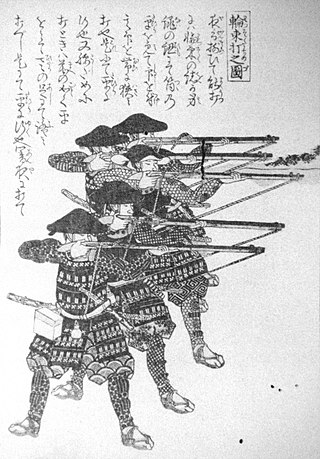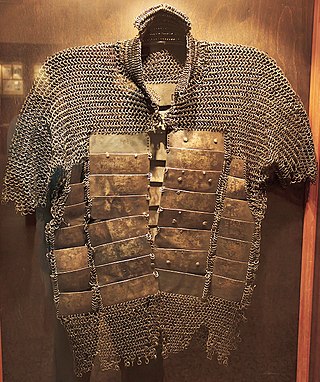

Munition armour (also "munitions-grade armour", "munition quality armour") was mass-produced armour stockpiled in armouries to equip both foot soldiers and mounted cuirassiers.


Munition armour (also "munitions-grade armour", "munition quality armour") was mass-produced armour stockpiled in armouries to equip both foot soldiers and mounted cuirassiers.
During the Late Middle Ages, plate armour was expensive and tailor-made for the wearer. Consequently, it was generally reserved for nobility. During the English Civil War, a cuirassier's armour could weigh between 32 and 45 kilograms (71 and 99 lb), [1] making this form of armour prohibitively costly and heavy. For these reasons, full plate armour started to disappear during the first few years of the conflict. Early Modern warfare was characterized by the establishment of standing armies equipped with mass-produced ordnance weapons.
Munitions-grade armour was produced in both Europe and Japan beginning in the 15th century to equip the standing armies developed from this period.
Munition armour was of a standard pattern with interchangeable pieces. It was often made of iron or sometimes an alloy of iron containing a small amount of phosphorus, which gave a marginal increase in hardness. [2] The phosphorus content may have been due to the use of high-phosphorus ores or the use of coal in smithing. [3]
In Japan, the warfare of the Sengoku period (15th and 16th centuries) required large quantities of armour to be produced for the ever growing armies of foot soldiers ( ashigaru ). Simple munition quality (okashi or lent) [4] cuirasses (dō) and helmets ( kabuto ) were mass-produced including foldable suits, like tatami armour. [5] Tatami armour was made from small iron or leather plates that were usually connected to each other by mail. [6]

Armour or armor is a covering used to protect an object, individual, or vehicle from physical injury or damage, especially direct contact weapons or projectiles during combat, or from a potentially dangerous environment or activity. Personal armour is used to protect soldiers and war animals. Vehicle armour is used on warships, armoured fighting vehicles, and some combat aircraft, mostly ground attack aircraft.

A cuirass is a piece of armour that covers the torso, formed of one or more pieces of metal or other rigid material. The word probably originates from the original material, leather, from the French cuirace and Latin word coriacea. The use of the term "cuirass" generally refers to both the breastplate and the backplate pieces; whereas a breastplate only protects the front, a cuirass protects both the front and the back of the wearer.

Ashigaru were infantry employed by the samurai class of feudal Japan. The first known reference to ashigaru was in the 14th century, but it was during the Ashikaga shogunate that the use of ashigaru became prevalent by various warring factions.

Plate armour is a historical type of personal body armour made from bronze, iron, or steel plates, culminating in the iconic suit of armour entirely encasing the wearer. Full plate steel armour developed in Europe during the Late Middle Ages, especially in the context of the Hundred Years' War, from the coat of plates worn over mail suits during the 14th century, a century famous for the Transitional armour, in that plate gradually replaced chain mail.

Cuirassiers were cavalry equipped with a cuirass, sword, and pistols. Cuirassiers first appeared in mid-to-late 16th century Europe as a result of armoured cavalry, such as men-at-arms and demi-lancers discarding their lances and adopting pistols as their primary weapon. In the later part of the 17th century, the cuirassier lost his limb armour and subsequently wore only the cuirass, and sometimes a helmet. By this time, the sword or sabre had become his primary weapon, with pistols relegated to a secondary function.

Kabuto is a type of helmet first used by ancient Japanese warriors that, in later periods, became an important part of the traditional Japanese armour worn by the samurai class and their retainers in feudal Japan.

The harquebusier was the most common form of cavalry found throughout Western Europe during the early to mid-17th century. Early harquebusiers were characterised by the use of a type of carbine called a "harquebus". In England, harquebusier was the technical name for this type of cavalry, though in everyday usage they were usually simply called 'cavalry' or 'horse'. In Germany they were often termed Ringerpferd, or sometimes Reiter, in Sweden they were called lätta ryttare.
The Kabutowari, also known as hachiwari, was a type of knife-shaped weapon, resembling a jitte in many respects. This weapon was carried as a side-arm by the samurai class of feudal Japan.

The ō-yoroi (大鎧) is a prominent example of early Japanese armor worn by the samurai class of feudal Japan. The term ō-yoroi means "great armor".

Lobster-tailed pot helmet, also known as the zischägge, horseman's pot and harquebusier's pot, was a type of combat helmet. It was derived from an Ottoman Turkish helmet type. From c. 1600, it became popular in most of Europe and was especially worn by cavalrymen and officers. The helmet gradually fell out of use in most of Europe in the late 17th century; however, the Austrian heavy cavalry retained it for some campaigns as late as the 1780s.

Men-yoroi (面鎧), also called menpō (面頬) or mengu (面具), are various types of facial armour that were worn by the samurai class and their retainers in feudal Japan. These include the sōmen, menpō, hanbō or hanpō, and happuri.

Sangu is the term for the three armour components that protected the extremities of the samurai class of feudal Japan.

Mail and plate armour is a type of mail with embedded plates. Armour of this type has been used in the Middle East, North Africa, Ottoman Empire, Japan, China, Korea, Vietnam, Central Asia, Greater Iran, India, Eastern Europe, and Nusantara.

Scholars agree that Japanese armour first appeared in the 4th century, with the discovery of the cuirass and basic helmets in graves. During the Heian period (794–1185), the unique Japanese samurai armour ō-yoroi and dō-maru appeared. The Japanese cuirass evolved into the more familiar style of body armour worn by the samurai known as the dou or dō, with the use of leather straps (nerigawa), and lacquer for weatherproofing. Leather and/or iron scales were also used to construct samurai armours, with leather and eventually silk lace used to connect the individual scales (kozane) of these cuirasses.

Kikko are small iron or hardened leather, hexagon shaped armour plates used in the construction of Japanese armor worn by samurai and ashigaru of feudal Japan.

Laminar armour is an armour made from horizontal overlapping rows or bands of, usually small, solid armour plates called lames, as opposed to lamellar armour, which is made from individual armour scales laced together to form a solid-looking strip of armour. Prominent examples of such armour are lorica segmentata of Ancient Rome and certain versions of samurai armour.

Tatami (畳具足), or tatami gusoku, was a type of lightweight portable folding Japanese armour worn during the feudal era of Japan by the samurai class and their foot soldiers (ashigaru). The Tatami dō or the tatami katabira were the main components of a full suit of tatami armour.

Dō or dou (胴) "breastplate, cuirass" is one of the major components of Japanese armour worn by the samurai and ashigaru or foot soldiers of feudal Japan.

Kusari katabira is the Japanese term for mail armour. Kusari is a type of armour used by the samurai class and their retainers in feudal Japan. When the word kusari is used in conjunction with an armoured item, it usually means that the kusari makes up the majority of the armour defence.

Karuta was a type of armour worn by samurai warriors and their retainers during the feudal era of Japan. The word karuta comes from the Portuguese word meaning "card" (carta), as the small square or rectangular plates that compose the armour resemble traditional Japanese playing cards.